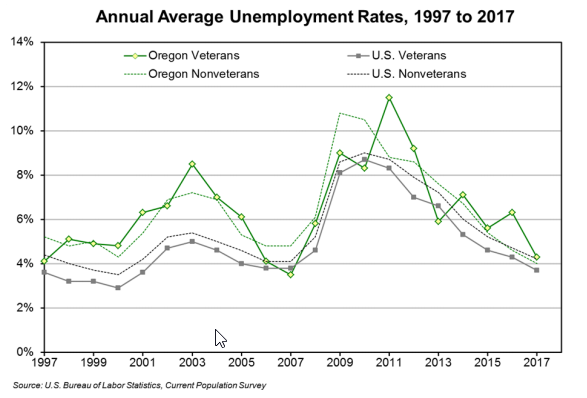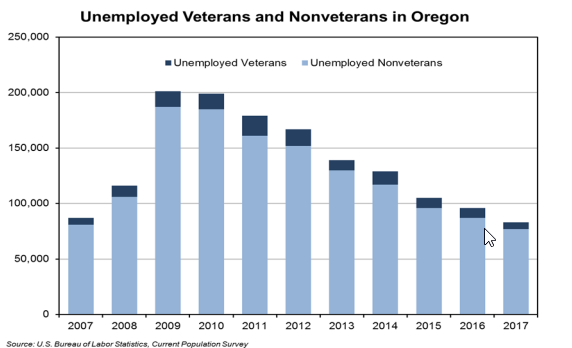Employment Among Oregon’s Veterans
In 2017, the unemployment rate for veterans in Oregon was 4.3 percent, according to the Current Population Survey. This was the lowest unemployment rate for veterans since 2007, when the unemployment rate was 3.5 percent. Overall, Oregon’s unemployment rate was 4.1 percent in 2017. Across the U.S., veterans had a lower unemployment rate of 3.7 percent.

About 305,000 veterans lived in Oregon in 2017. Half of veterans (153,000) were not in the labor force. This figure could be related to the age of veterans. According to the American Community Survey, more than half of Oregon’s veterans were age 65 years or older and served in the military at least four decades ago: Vietnam War (110,668 veterans), Korean War (23,024), and World War II (9,491). Gulf-War I and II veterans accounted for 90,412.
Around 145,000 of the 152,000 veterans in the labor force were employed, with 123,000 being employed full time and 22,000 part time. About 6,000 veterans were unemployed, which accounted for 7.2 percent of the unemployed population (83,000) in the state. Over the last two decades, unemployed veterans made up between 6.9 percent and 14.6 percent of the overall unemployed population in the state.
Veterans are employed across all industries. In the United States, manufacturing (12.1% of veterans); professional and business services (10.8%); retail trade (8.6%); and education and health services (8.2%) are industries where a large number of veterans are employed. About 21.7 percent of veterans work in government.
Veterans work in various occupations. About 20.1 percent of veterans in the U.S. work in professional and related occupations; 19.3 percent work in management, business and financial occupations; 13.9 percent in service occupations; and 10.2 percent in transportation and material moving occupations.
In 2017, Oregon’s veterans earned a higher median income ($37,556) than nonveterans ($29,592). Education could be one of the factors influencing veterans’ higher median income. Among Oregon veterans ages 25 years and older, 41.6 percent have an associate’s degree or some college compared with 33.2 percent of nonveterans. About 5.6 percent of veterans don’t have a high school diploma, while 9.4 percent of non-veterans don’t have a high school diploma. Higher educational attainment generally translates into higher earnings.

Female veterans, who represented 8.2 percent of Oregon’s veterans, earned a median income of $28,538, less than male veterans’ median of $38,501, but higher than female non-veterans’ income of $24,353.
Veterans are more likely to have a disability, but less likely to be in poverty than the general population. About 32.8 percent of Oregon’s veterans reported having a service-connected disability, compared with 15.1 percent of the total civilian population. About 8.1 percent of veterans were in poverty compared with about 12.8 percent of the total civilian population.
More information about veterans is available in the U.S. Bureau of Labor Statistics’ “Employment Situation of Veterans”.



Advertisement